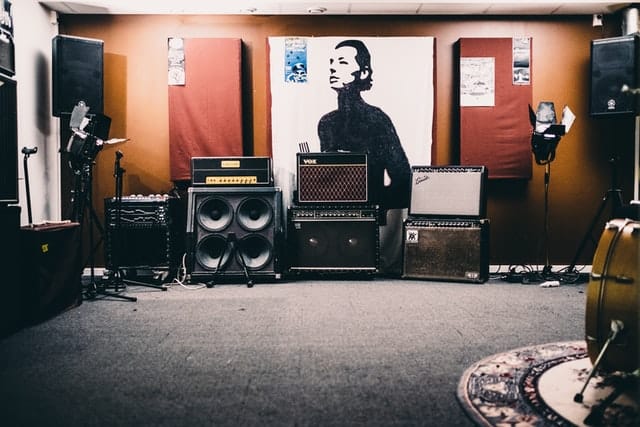There is no direct answer to this question. But, there are ways to convert it if you need to. One of the ways is to buy a dual-voltage amplifier.
These are designed to run on two different voltages and can step up from a 110V supply to a 220V one.
Typically, these amps have a switch that changes the transformer settings to work with the voltage it receives.
A power transformer is an alternative, but in the case of guitar amps, you shouldn’t go for anything lower than the high-end, which can be very expensive.
Cheaper alternatives are likely to not be so reliable and even generate unwanted interference and noise.
If you’re concerned about the compatibility of your amp with different voltages, you should try buying one that supports both.
Otherwise, you may find yourself stuck with an amplifier that can’t function properly in a particular country.
So, in short:
Before plugging a 230v amp into a 110v socket you should check if it’s a multi-voltage amplifier. Many modern units are. Another alternative is getting a high-quality power transformer to use with your amp, or just installing a socket that runs the voltage the amp requires for its exclusive use.
In this article, I will tell you all you need to know about amp compatibility across different grids.
After leaving this page you will have a clearer idea if it’s a good choice to get an amp abroad.
Are you ready to get started?
Let’s go!
Do European amps work in American power sockets?
Well, most amps are switchable between two different voltages, so if you’re going on a vacation to Europe, you’ll probably have one of the biggest questions:
Do European amps work in an American power socket?
The answer depends on which region you’re traveling to. While the United States uses 110V, most European countries use 220V power.
You’ll need an adapter to use an American device in a European power socket.
In addition, look for a printed voltage range on the plug to determine if it’s compatible with European power sockets.
If it doesn’t, you may have to purchase a power converter, converting European 220V to 110V.
If you’re unsure whether your amp will work in either country, look at its back panel for markings that tell you what voltage it’s designed to operate.
Can you damage an amp if you plug it into a different voltage grid?
Not matching operating and grid voltages on any appliance will always open the gates for trouble.
Don’t get me wrong, I’m not saying your amp will explode, but unintended things might happen.
A 230v amp connected to a 110v plug will likely sound awful. It’s just that the whole system is calibrated for a different power source.
Will it be damaged? It’s hard to tell, but many specialists say that the first failing point could be the power tubes.
And you don’t really want to damage your power tubes, do you?
If we are talking about the other way around, running a 110v amps into a 230v socket, a likely outcome is that you will blow a fuse inside the circuit.
What are the alternatives for using a 220v amp with 110v?
Getting to use a 220v amp in a 110v context will require some workarounds, but it’s doable.
First, if the amp is a multi-voltage unit, you are good to go. It will probably require you to flick a switch in the back panel, or even automatically adapt to the power source.
If this is not the case, I can think of 3 possible alternatives:
1. Using a power adapter
This is perhaps the easier way around.
You will need to get a specific power adapter that just transforms 110v volts into the required 230v.
Although simple, this is not perfect since adding extra steps to the power flow will make it more prone to interferences or unwanted noises, particularly if the adapter is of lower quality.
Touring musicians, however, bring big universal power adapter units everywhere they go, just to ensure their power source is always compatible and of good quality.
2. Installing a 230v socket
You can talk to a certified electrician and ask for the installation of a 230v socket near your amp for its exclusive use.
This is a rather complicated solution that will tie your amp’s usage to a particular room in your house, and require some house modifications that you might not be up to doing.
3. Replacing the amp’s transformer
Finally, you can always bring the amp to an amp tech and ask for their recommendations.
Maybe replacing the original transformer with a different one designed to work with your power grid would be a possible workaround.
But take into consideration that transformers are one of the factors that shape the tone of a particular amp.
Are guitar amp transformers prepared for different voltages?
Modern guitar amp transformers are usually prepared for dealing with different international power grids.
This is particularly true for most popular high production models.
You see, manufacturers found out that it’s easier and even cheaper to solve the different voltage issues when the amp is made, than having to deal with many different regulatory agencies and standards at the time of importing their products to different countries.
For vintage amps, this might not be the reality, but it will depend on a case-by-case basis.
Again, and as I said and will say many times in this article. Always read the labels and the indications on the backplate of the unit, the power cord, and if in doubt, also on the user’s manual.
How to know if your amp is prepared for your energy grid?
Today, the word “grid” has a different meaning than when it was first invented. It refers to a group of technologies owned by thousands of entities, from government agencies to homeowners with rooftop solar panels.
The contiguous United States has three central interconnected power systems: the Eastern Interconnection (which covers everything east of the Rocky Mountains) and the Western Interconnection (the West). These systems are connected to serve our power needs.
Usually, amps have labels that clearly indicate how they should be used in their backplate.
You should always pay extra attention to the manufacturer’s indication either there, or in the user’s manual, especially if you have doubts about the compatibility of that unit with your local energy grid.
What to do if your amp has a plug prong configuration that doesn’t match your sockets?
A different prong configuration from the one on the sockets at home might mean that the amp was not intended to be sold in your country.
Usually, nations enforce strict electrical security controls on imported electronics that requires them to be adapted to the local standards.
When bringing an amp from abroad, it’s common you might face this issue. The simpler solution is just using an adapter.
Also, you could probably get a power cable with the same female end that the amp uses, but with the male end that your house prefers.
Again, it’s important that you read all the labels and manuals before getting any replacements. Particularly if you don’t really know what you are doing.
Finally, and as I mentioned for transformers earlier, adding complexity to your power source could increase your chances of getting unwanted interferences or noises.
Recommendations when buying amps abroad
When buying a guitar or amp in another country, read the instructions on the packaging and safety measures.
Ask around, but verify everything.
Sellers are usually keen on making deals and know that if you will be traveling out in a week you will probably have trouble bothering them again if something doesn’t work as intended.
You should also check that the amp is well maintained and has no signs of improper use or storage.
Try everything before you pull the plug.
Look for well-known brands that offer warranty coverage in your home country.
Google any compatibility issues that might worry you, from power cord prongs to voltage to tube availability for replacement, etc.
Finally, if it’s an alternative, control your impulse buy and wait until you are home to order the unit from a local seller.
This way you will have a closer-to-home contact in case a problem emerges.

Hello there, my name is Ramiro and I’ve been playing guitar for almost 20 years. I’m obsessed with everything gear-related and I thought it might be worth sharing it. From guitars, pedals, amps, and synths to studio gear and production tips, I hope you find what I post here useful, and I’ll try my best to keep it entertaining also.





